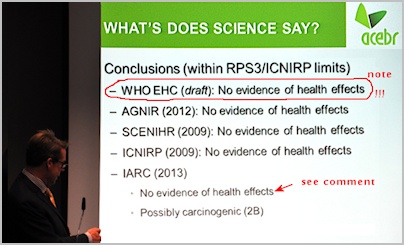 |
 |
|
 |
 |
About Us | Contact |
|
|
21/12/2014 - Pointless WHO EHC consultationThe International EMF Project, founded by Mike Repacholi (who had previously masterminded the creation of ICNIRP) which is run under the auspices of the World Health Organization is currently conducting a review of the research on radiofrequency electromagnetic fields (RF EMFs). They made public a first draft of part of their Environment Health Criteria Monograph (EHC-RF 2014) in September 2014, but crucially this is missing three critical chapters: the overall report summary, the risk assessment section and the chapter on protective measures. Furthermore, the chapters that are present on the science itself are almost all missing chapter conclusions. As a result, opening the report to public consultation is almost entirely pointless - the only comments that could be of value at this stage are listing papers that have been excluded without explanation published prior to 2012 (by their own admission they had not, so far, included any papers published since then). It is not possible to comment on the advice that will go to the general public as that advice simply hasn't been written yet. We also note that no further consultations before final publication of the whole EHC report. 
The present "public consultation" seems to be some "tick-box" public relations exercise as the final result seems to already have been decided. This is shown in a very concerning presentation by Rodney Croft at the recent ICNIRP workship in November this year (2014) which summarised the forthcoming WHO EHC-RF content as finding "No evidence of health effects" (see picture - courtesy Dariusz L's blog). Croft's slide also lists IARC (2013) as judging "No evidence of health effects" - this is quite incorrect - they did not assess the evidence for "health effects" other than for carcinogenicity where they judged RF exposure as a 2B "possible human carcinogen". The slide title is also faulty. Co-ordinated by the International EMF Alliance (IEMFA), 49 NGO-type organisations (including Powerwatch) from Europe and the US have produced a formal critique outlining several problems with the report and calling for an official response from WHO. They include criticisms of the lack of transparency surrounding the selection of the experts for the new monograph, and question the objectivity of the World Health Organization in the choices that have been made. Dariusz Leszczynski has posted another excellent "Between a Rock and a Hard Place" blog with a CHALLENGE for Dr van Deventer (PhD Engineering) of the WHO EMF Project. This contains much more information about the authors of the draft EHC than we include in this news item. Of the original 31 members of the IARC monograph panel that classified RF EMFs as a class 2B carcinogen, only 6 are present in the EHC-RF 2014 group, of which only 1 is one of the core group. 25 of the IARC monograph 102 members are conspicuously absent, including the vast majority of those who voted to increase the classification from 3 to 2B. There is also a significant overlap of key and outspoken ICNIRP scientists on the WHO team writing the EHC Monograph, so it is perhaps not surprising that they are likely to support the high ICNIRP Guideline exposure levels. There is an active (21 December 2014) Avaaz petition calling for IARC/WHO to reassess the group 2B classification as Group 1 ('known human carcinogen'). Conspiracy theories are always rather unseemly, but since Joachim Schüz took over the helm of IARC's environment section in 2010 there has been a steady shift of scientists invited to contribute to their reports. Previously there were scientists with specific expertise in EMF related research mixed with scientists from other environmental disciplines, and a healthy collection of scientists on both sides of the "do electromagnetic fields cause harm" debate; now there is a clear majority of researchers who have been outspoken in saying that there is neither sufficient evidence to be concerned about EMFs, nor is an association with health even plausible. This lack of balance will naturally lead to conclusions and documents that reflect it. The WHO RF EHC core group
The assisting experts
Links» NGO response to WHO Consultation signed by 49 organisations Also in the newsNew York Times power line spinPaul Brodeur of the Huffington Post ran an excellent article last week criticising the New York Times for a one-sided coverage of overhead power lines and public health (particularly childhood leukaemia). Drawing references to the handling of asbestos in the 1970's and 80's, Mr Brodeur points out that the primary protagonists of "impartial evidence" used by the Times have a track record of being paid by the electricity industry to proclaim the safety of extremely low frequency electromagnetic fields in court - something which they failed to make clear to its readership. This is of course hardly a new thing in controversial areas of science, and we've seen it all before in cases from tobacco to mobile phones, but it's sad to see such clear evidence of it in such a prominent source of news. » Original Huffington News article This page has links to content that requires a .pdf reader such as |

